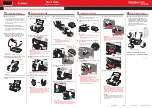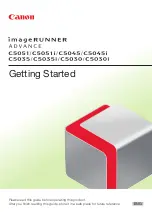
T480
Programmer’s Guide
T480 Unicode and Fonts
100-14362
Rev A
Page 203
when it is rendered. The third requires that the diacritical mark be positioned over the
character.
The Unicode standard does not always make it clear how the diacritical marks are
defined. In general characters from 0x300 through 0x36F are defined as combining
diacritical marks. In this case, the character to character to be modified should be
followed by the combining diacritical mark. The EPIC 3000 printer will position the
diacritical mark over the previous character as defined by the diacritical mark. The
printer does not control the positioning of the diacritical mark. The diacritical mark
defines the fall back amount.
In the case where the diacritical mark is defined as a character, there is no negative
motion in the diacritical marks definition so the host system must position the character
entry position back to the previous character. This is may be done with a set position
command or a simple backspace command. If backspace is used the printer will keep
track of the width of the previous character and reposition the entry pointer to the end of
the original character after the diacritical mark is rendered.
The EPIC 3000 printer does not handle multiple diacritical marks on the same character.
The printer will not shift the second diacritical mark to prevent it from interfering with the
previous. The EPIC 3000 processes the diacritical marks as defined in the font.
Character Cache
The EPIC 3000 supports a high speed character cache that can cache character
bitmaps, outlines, tiles, or bands of characters. The caching technique is based on a
least-recently used (LRU) algorithm. The Cache contains an entry for each size of
character used. The amount of space in the cache used by each character is dependant
on the size of the character.
At power up, the character cache is empty. The first ticket will require that all characters
to be printed be generated from the vector data. This will typically make the first ticket
slightly slower than subsequent tickets. It is also possible to define a user defined font
with different metrics that will cause the cache to be flushed when any of the user
characters are being accessed. If this should occur, the user defined font should be
changed to match the other fonts in the printer.
Stacked or Linked fonts
The EPIC 3000 also uses a font stacking technology where fonts are linked together.
This means that as each character is looked up, the first font in the stack containing the
character is then printed. For example, if a customer would like to replace several
standard characters with custom characters, a user defined font can be provided that
would, if first in the link, replace the characters n the standard font.
It may also be desirable to stack fonts to provide a precedent for how individual
characters are looked up. For example:
An application may wish to alter the appearance of several characters for
security.
It might be necessary to define a group of special symbols for a specific
application.
It might be necessary to supplement a font with special characters like
OCR characters.
Содержание Epic 3000
Страница 1: ...Epic 3000 Programmer s Guide PN 100 14362 Rev A Dec 2015...
Страница 2: ...Programming Codes Epic 3000 Programmer s Guide Page 2 Rev A 100 14362...
Страница 266: ......
















































